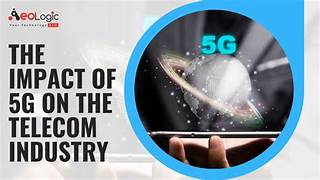5G Technology: Impact on Telecommunications Industry Revenue
The advent of 5G technology marks a paradigm shift in the telecommunications industry. Offering unprecedented speed, low latency, and increased connectivity, 5G has unlocked new opportunities for revenue generation and innovation. As global adoption accelerates, its impact on telecommunications companies is both profound and multifaceted. This article explores how 5G technology is transforming revenue streams, reshaping business models, and driving economic growth in the telecommunications sector.
The Evolution of 5G Technology
From 1G to 5G: A Brief Overview
- 1G: Introduced analog voice communication in the 1980s.
- 2G: Brought digital voice and text messaging in the 1990s.
- 3G: Enabled mobile internet and basic data services in the early 2000s.
- 4G: Revolutionized connectivity with high-speed internet and streaming capabilities.
- 5G: Designed to handle massive data volumes, support IoT devices, and deliver ultra-low latency communication.
Key Features of 5G
- Enhanced Speed: Up to 10 Gbps, significantly faster than 4G.
- Ultra-Low Latency: Response times as low as 1 millisecond.
- Massive Device Connectivity: Supports millions of devices per square kilometer.
- Network Slicing: Tailors network resources for specific use cases.
Revenue Opportunities Created by 5G
1. Enhanced Mobile Broadband (eMBB)
With its superior speed and capacity, 5G enables seamless high-definition streaming, cloud gaming, and virtual reality (VR) experiences. Telecommunications companies can offer premium data plans and value-added services to cater to consumer demand for high-quality digital experiences.
- Example: Telecom providers partnering with streaming platforms to bundle services and attract high-value customers.
2. Internet of Things (IoT)
5G’s ability to connect billions of IoT devices creates new revenue streams in sectors such as smart cities, healthcare, and industrial automation.
- Smart Cities: Revenue from 5G-powered solutions like traffic management, energy optimization, and public safety.
- Healthcare: Telemedicine, remote monitoring, and robotic surgeries powered by 5G connectivity.
- Industrial Automation: Supporting advanced manufacturing processes and supply chain optimization.
3. Private 5G Networks
Enterprises are increasingly adopting private 5G networks to ensure secure, high-performance connectivity for critical operations. Telecommunications companies can generate revenue by offering customized solutions and network management services.
- Use Cases: Factories, logistics hubs, and educational institutions deploying private networks for operational efficiency.
4. Fixed Wireless Access (FWA)
5G FWA provides an alternative to traditional broadband by delivering high-speed internet to homes and businesses without requiring physical cables. This solution is especially valuable in rural and underserved areas.
- Impact: Expands market reach and addresses the digital divide, driving subscription growth.
5. Augmented Reality (AR) and Virtual Reality (VR)
5G’s low latency and high bandwidth make immersive AR and VR applications viable for gaming, training, and entertainment.
- Monetization: Partnerships with content creators and hardware manufacturers to develop and distribute AR/VR solutions.
Reshaping Business Models in Telecommunications
1. Shift to Service-Based Models
Telecom providers are moving beyond traditional voice and data services to become end-to-end solution providers. This involves bundling connectivity with applications, platforms, and managed services.
2. Collaborative Ecosystems
The 5G ecosystem requires collaboration between telecom companies, technology providers, and industry verticals. Revenue-sharing models and joint ventures are becoming more common.
- Example: Partnerships between telecom providers and automotive companies to enable connected vehicles.
3. Cloud and Edge Computing Integration
5G enhances the capabilities of cloud and edge computing, enabling telecom companies to offer infrastructure-as-a-service (IaaS) and platform-as-a-service (PaaS) solutions.
- Benefit: Drives new revenue from enterprise customers seeking low-latency computing solutions.
Economic Impact of 5G Adoption
1. Job Creation
The deployment and maintenance of 5G networks create jobs in engineering, construction, and technology sectors. Additionally, new business opportunities in IoT, AR/VR, and smart solutions generate demand for skilled professionals.
2. GDP Growth
Studies estimate that 5G will contribute trillions of dollars to global GDP over the next decade by enhancing productivity and enabling innovation across industries.
3. Digital Transformation
5G accelerates digital transformation in industries such as healthcare, manufacturing, and retail, creating a ripple effect that boosts economic activity and consumer spending.
Challenges and Considerations
1. Infrastructure Investment
Building 5G networks requires significant capital expenditure. Telecommunications companies must balance network expansion with profitability.
2. Spectrum Allocation
Governments and regulatory bodies play a crucial role in allocating spectrum for 5G. Delays or inefficiencies can hinder deployment and revenue generation.
3. Security Concerns
With increased connectivity comes heightened security risks. Telecom providers must invest in robust cybersecurity measures to protect networks and user data.
4. Competition and Pricing Pressure
Intense competition among telecom operators may lead to price wars, impacting profitability. Differentiation through value-added services is essential.
Future Outlook
1. Global Expansion
As 5G deployment expands globally, telecom companies have the opportunity to tap into emerging markets and underserved regions.
2. Innovative Applications
The full potential of 5G will be realized through innovative applications such as autonomous vehicles, smart agriculture, and advanced healthcare solutions.
3. Sustainability
Telecommunications companies are exploring energy-efficient 5G infrastructure to reduce environmental impact and align with sustainability goals.
4. 6G on the Horizon
While 5G adoption is still underway, research into 6G technology has already begun. Preparing for the next wave of innovation will be crucial for long-term success.
Conclusion
5G technology represents a transformative force in the telecommunications industry, unlocking new revenue opportunities and reshaping business models. From enhanced mobile broadband to IoT applications and private networks, the potential for growth is immense. However, realizing this potential requires addressing challenges such as infrastructure investment, spectrum allocation, and cybersecurity.
As 5G adoption accelerates, telecommunications companies that embrace innovation and collaboration will be well-positioned to thrive in an increasingly connected world. By leveraging the capabilities of 5G, the industry can drive economic growth, enhance customer experiences, and shape the future of communication.


